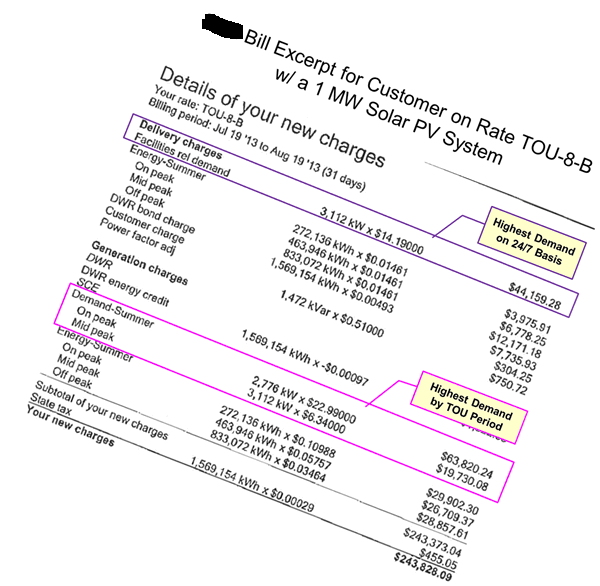The continuing decline in prices for energy storage and solar is creating huge opportunities for large electricity consumers. The need to reduce utility demand charges is a key driver of investments in solar-plus-storage systems. These systems allow grid-connected commercial and industrial (C&I) electric customers to shift to their own generation when they need more electricity, avoiding spikes in demand that translate to costly charges.
 Deconstructing Demand Charges
Deconstructing Demand Charges
Commercial and industrial demand charges are typically based on the peak demand during a 15-minute interval during a given month. For example, let’s assume you use an average of 200 kW during your peak 15-minute period. If you were paying a demand charge rate of $15 per kilowatt (kW), your total demand charges would be $3,000. That amount would be added to your energy charges, which are based on your total consumption of energy over the whole month.
The consequence of these rate structures is that two companies using exactly the same amount of energy in a given month can have wildly differing electricity bills. That difference is created by the demand charge, which expresses how “peaky” their load profile is. Demand charges can produce nasty surprises, causing electric bills to balloon after unpredictable events. Furthermore, they can be frustrating and confusing, varying considerably from one utility to the next in the same state or from one month to the next when very little has changed between those months.
In short, for commercial and industrial customers that pay thousands of dollars per month for electricity, this is an operational cost with profound impacts on the bottom line.The average monthly electric bill for industrial customers in Rust Belt states in 2016 was a whopping $20,506.86, according to the US Energy Information Administration. Demand charges can make up anywhere from 30-70% of that amount.
Commercial customers face a similar burden. According to a survey of commercial electricity customers by the National Renewable Energy Laboratory, over a quarter of them – or five million companies in the US – are paying high demand charges. And many of those customers have a poor understanding of how demand charges impact their electricity bills. The traditional rationale for demand charges has been that because electricity could not be stored, utilities needed to maintain, on standby, expensive generation capacity that is only needed for their peaks.

Photo: NREL
Storage and Onsite Generation Provide New Options for Controlling Demand Charges
But things are changing, now that electricity can be stored, the price of storage is dropping by the day, and battery costs could decline a further 70% in the next 15 years. If companies invest in solar-plus-storage systems that kick in when there is heavy electricity usage, they can flatten out their own demand peaks. That process is called “peak shaving,” and it helps avoid an unpleasant surprise at the end of the month when the electric bill arrives.
Commercial and industrial companies have been investing in lowering their energy bills for several decades. These investments have included energy efficiency, rescheduling industrial processes to avoid high peak electric rates, and direct investments in renewable energy. Solar energy alone, however, cannot reliably reduce demand charges, because sometime during a month it is likely that cloudy weather will occur at just the wrong time. The only way to control that is to dispatch stored power at that time.
But how can companies figure out how to do this? The savings from a storage or microgrid system depends strongly on site-specific conditions, such as the actual load profile. How can they model potential savings to determine whether they are a good fit for peak shaving investments? HOMER Energy has designed a new tool, HOMER Grid, to help C&I electricity customers determine the best onsite generation and storage solutions, and it will be available in the spring of 2018.
HOMER Grid – Reducing demand charges
Based on the well-known microgrid optimization software HOMER Pro, HOMER Grid will model and compare multiple distributed energy resource (DER) systems that combine distributed solar, storage and backup generation. In early access now, the web-based version of the tool connects to a national database of utility tariffs, and walks users through the process of uploading load data, or choosing sample commercial profiles. It then reports summary configurations for optimal solar-plus-storage systems to show users their potential savings. The report compares a range of capital and operating costs and payback periods for designs with varying amounts of solar and battery assets and different types of backup generation.
After working with the web version of HOMER Grid, users should know which system is the best choice for their particular load profile, utility rate structure, weather conditions, and technology preferences. The desktop version of HOMER Grid will provide these same features along with more detailed modeling of hybrid renewable energy systems. Users will be able to enter detailed installed and operational costs of their components, perform risk and sensitivity analyses on their models, model with utility rates from the US, Canada, Mexico and Australia, and test the impact of complex incentives like the ITC, among other things.
To find out more about how to use HOMER Grid for your facility or your customers, please email us at .
